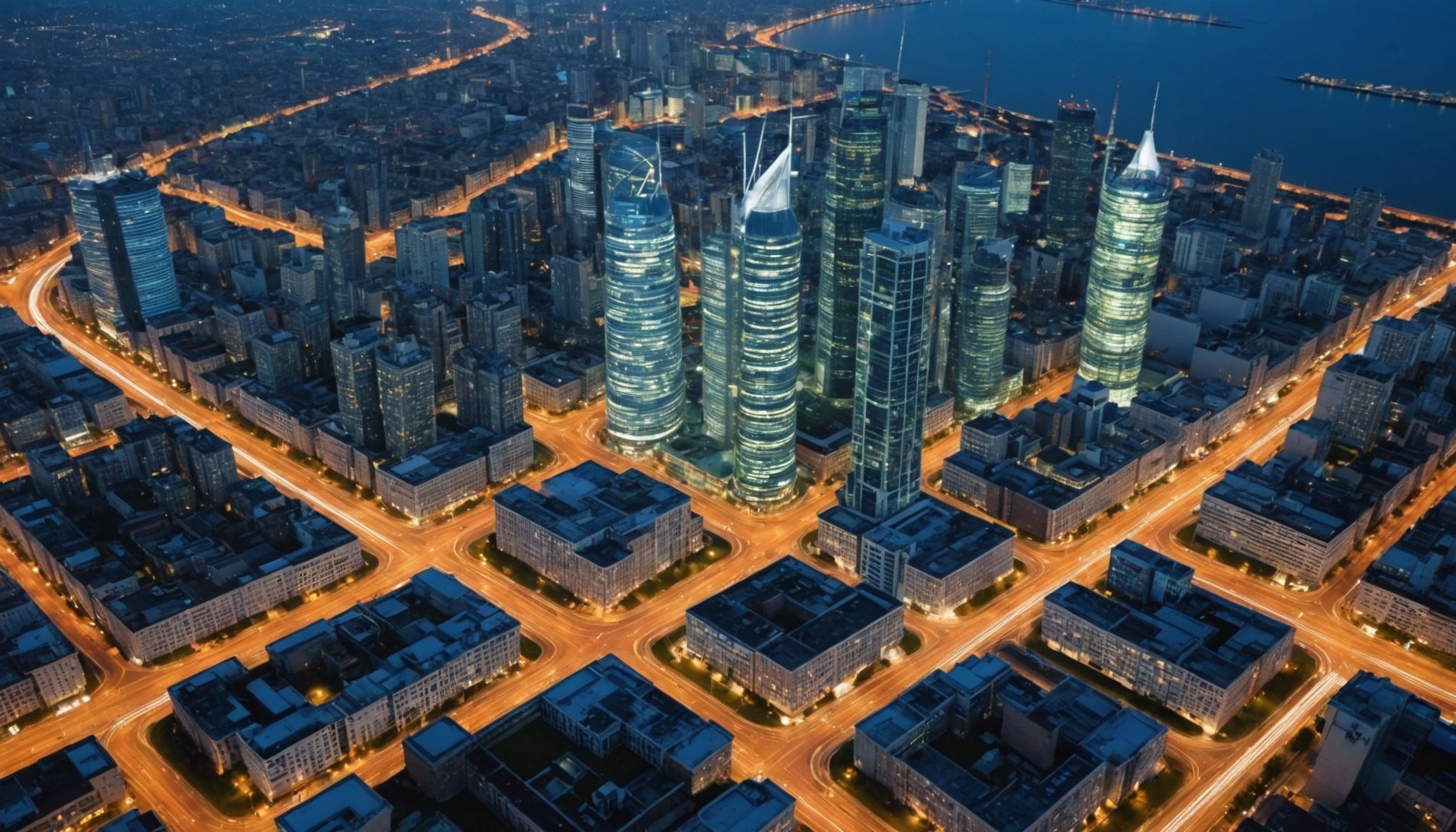Overview of Smart Grid Technology
Smart grid technology represents a revolutionary shift in how energy is managed and distributed. Unlike traditional grids, which primarily focus on delivering electricity from power plants to homes and businesses, smart grids are integrated systems that utilise digital communication technologies. These technologies facilitate the two-way flow of information and electricity, paving the way for a more efficient and reliable energy system.
At its core, a smart grid includes several components such as sensors, automated control systems, and advanced metering infrastructure. These elements work together to enhance energy efficiency by providing real-time data that helps in managing electricity use better. Furthermore, smart grids empower users through intelligent monitoring, allowing them to adjust their consumption patterns to align with peak efficiency times.
Also to read : Mastering Real Estate Triumph: Essential Tactics for Navigating Risk in Unpredictable Markets
Regarding urban sustainability, smart grids significantly contribute by integrating renewable energy sources into the system, thereby reducing reliance on fossil fuels. This not only cuts down emissions but also bolsters the resilience and reliability of the energy supply. In summary, the key differences between traditional grids and smart grids lie in the latter’s ability to offer greater flexibility, insight, and sustainability in energy management.
Applications of Smart Grids in Urban Environments
In urban environments, smart grids are transforming energy management through innovative applications. A critical aspect includes the integration of renewable energy sources in city grids. By incorporating solar, wind, and other renewables, cities can reduce dependence on fossil fuels, cutting emissions and supporting sustainability goals. This integration requires advanced technologies for balancing supply and demand, ensuring a consistent and reliable energy flow.
In the same genre : Maximize Office Energy Efficiency: Cutting-Edge HVAC Optimization Strategies for UK Workspaces
Moreover, real-time energy management and monitoring systems play a pivotal role in optimizing urban energy consumption. These systems provide instant data access, allowing utilities and consumers to adjust usage and improve efficiency dynamically. With the capability of predicting energy needs, these systems help in managing peak load times, reducing costs and energy waste.
Additionally, smart grids pave the way for enhancing public transportation through smart grid solutions. Electric vehicles (EVs) and public transit are significant beneficiaries, as smart grids enable efficient energy distribution and charging solutions. By reducing downtime and improving energy allocation, cities can enhance the reliability and usability of public transport systems. This not only offers cost savings but also contributes to a cleaner urban environment, reinforcing the sustainable impacts of smart grid applications.
Case Studies of Successful Smart Grid Implementations
Examining smart grid success stories provides insightful examples of efficient urban energy management. Smart cities worldwide, such as Amsterdam and Singapore, lead the way with their strategic smart grid deployments. Amsterdam, for instance, focuses on integrating renewable energy sources, enhancing grid reliability and sustainability. Singapore, on the other hand, employs real-time energy management systems, significantly reducing energy consumption and optimizing resources.
Smart Cities Leading the Way
Amsterdam and Singapore showcase the ability of smart grids to revolutionize urban energy systems. Amsterdam’s project involves demand response technologies, enabling consumers to adjust energy use according to real-time supply levels. This initiative has led to notable energy savings and increased reliance on local solar and wind power.
Innovative Projects Across the Globe
Globally, innovative projects like New York’s microgrid clusters highlight the potential for urban environments to harness localized energy sources. This approach enhances energy security and reduces dependence on central power plants.
Lessons Learned from Smart Grid Initiatives
The primary lesson from these initiatives underscores the importance of integrating advanced technologies with active community participation. Collectively, these case studies demonstrate how blending technology with human-centric designs can overcome challenges and create resilient energy frameworks. It is critical to adapt solutions to local contexts for sustainable outcomes.
Benefits of Smart Grids for Urban Residents
Incorporating smart grids in urban areas offers numerous benefits for residents, significantly enhancing the reliability and resilience of energy supply. Unlike traditional grids, smart grids use real-time data to identify and respond to disturbances quickly, reducing outages and ensuring a consistent power flow.
Furthermore, smart grids lead to cost savings by optimizing energy usage. Advanced systems track energy consumption patterns, allowing residents to adjust their usage during peak times, thus reducing energy bills. The precise monitoring of electricity usage helps households become more energy-efficient, promoting sustainable living practices.
Another critical advantage of smart grids is environmental. By integrating renewables and reducing reliance on fossil fuels, smart grids contribute to urban sustainability, significantly lowering carbon footprints. This reduction in emissions supports cleaner air and healthier living conditions for urban populations.
The transition to smart grids also empowers residents to actively participate in energy management. With access to detailed usage data, individuals can make informed decisions regarding their consumption and contribute to a greener environment. These benefits align with the growing emphasis on urban sustainability, positioning smart grids as pivotal in modern city planning and energy strategies.
Future Trends in Smart Grid Development
The future of smart grids is poised for remarkable advancements, ushering in enhanced capabilities and sustainability benefits. Notably, the integration of emerging technologies such as the Internet of Things (IoT) and Artificial Intelligence (AI) will revolutionise grid systems. IoT plays a crucial role in enabling real-time monitoring and control, enhancing grid efficiency and responsiveness. AI, meanwhile, optimises energy distribution and forecasts consumption patterns, allowing for smarter, data-driven decisions.
Community engagement is pivotal in the development of sustainable grids. As urban areas evolve, involving residents and stakeholders ensures that the grids meet local needs effectively. This collaboration fosters a sense of ownership and awareness regarding energy use and conservation.
Looking ahead, new trends point towards increased microgrid installations, promoting distributed energy resources. These microgrids enhance energy resilience, particularly in disaster-prone and remote areas, ensuring localised supply during outages. Additionally, advancements in energy storage technologies will further stabilise grid operations, integrating more renewable sources.
In summary, the future of smart grids holds the promise of greater sustainability, efficiency, and reliability, driven by cutting-edge technology and community involvement. These innovations are central to achieving urban sustainability and advancing global energy goals.
Challenges in Integrating Smart Grids
Integrating smart grids into urban energy frameworks presents distinct challenges, particularly in technical and infrastructure domains. One prominent technical challenge is the requirement to upgrade existing electrical systems. This involves substantial investments to accommodate digital communication technologies and advanced metering infrastructure, ensuring the two-way flow of information and electricity.
In addition to technical hurdles, policy and regulatory frameworks pose significant barriers to smart grid adoption. The alignment of national and local regulations is crucial to support the seamless integration of smart grids. Regulatory bodies must adapt and set standards that encourage the deployment of smart grid technologies, promoting urban sustainability.
Cybersecurity and privacy concerns are critical considerations in smart grid integration. As more devices connect to the grid, ensuring secure data exchange and protection against cyber threats becomes paramount. Implementing robust cybersecurity measures is essential to maintain the integrity and reliability of smart grids.
- Technical challenges requiring infrastructure upgrades
- Alignment of policy and regulatory frameworks
- Ensuring robust cybersecurity protections
Addressing these challenges is vital for effectively implementing smart grids, facilitating urban sustainability and resilience. By overcoming these obstacles, cities can harness the full potential of smart grids, achieving efficient and reliable energy management.
Impacts on Energy Consumption and Sustainability
Smart grids dramatically enhance energy efficiency by reducing peak energy demand. Real-time data allows utilities to manage load distribution effectively, minimizing energy waste. Cities experience a reduction in electricity consumption during peak hours, leading to fewer blackouts and lower operational costs. By balancing supply and demand, smart grids contribute to efficient resource utilization, driving the transition to sustainable urban development.
The influence of smart grids extends beyond energy management, affecting both local and global environmental policies. By integrating renewables and minimizing reliance on fossil fuels, smart grids support initiatives aimed at reducing greenhouse gas emissions. This aligns with international climate agreements, thereby encouraging nations to adopt cleaner energy practices. Such alignment not only results in policy innovation but also promotes environmental preservation on a broader scale.
Moreover, smart grids can foster a circular economy by optimizing energy production and distribution. Enhanced energy storage solutions and decentralised energy systems reduce waste, encouraging resource recirculation. This approach not only bolsters economic resilience but also promotes sustainable practices across various sectors, reinforcing the role of smart grids in achieving urban sustainability. Smart grids thus represent a pivotal step towards a greener, more energy-efficient future.






